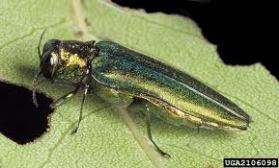We’re under attack!
An invasive beetle called the Emerald Ash Borer (EAB) is taking over our forests and wreaking havoc on our ash trees. Unlike our native borers, this Asian import has gotten out of control. It’s already killed tens of millions of ash trees, and it doesn’t appear to be slowing down. Since this topic is more serious than some of the others, I’ve decided to lighten it up with some tree jokes. Hopefully that will offset some of your tree-grief.
What kind of tree can fit in your hand? A palm tree!
How can you identify EAB?
 Cross your fingers you never see this bug!
Cross your fingers you never see this bug!
The adult beetle is about half an inch long and a bright metallic green. However, if you have EAB in your trees you may not ever actually see the insect. Fortunately, there are simpler ways to identify an infestation. Symptoms include:
- Losing leaves in the top third of the canopy
- Sprouting in unusual places like the roots or trunk
- Splitting bark
- Increased woodpecker activity (they may be the only ones who actually like EAB!)
- You may find tiny D-shaped holes where the adults have emerged, but often the bark is too furrowed to see them
Alas, many of these symptoms can also be caused by other non-EAB issues. The one sure-fire way to identify EAB is to peel back part of the bark and look for “galleries”, or narrow serpentine tracks where a borer has eaten its way through the tree.

These galleries are a pretty reliable indicator of EAB
What did the tree do when its bank closed? It started a new branch!
What can we do about it?
This is the worst part: once a tree is noticeably infected it’s pretty much a goner. Likely, your best bet is to cut the tree down so that it doesn’t spread to neighboring ash.
The USDA has gone so far as to impose ash quarantine areas to try to contain the pest. It seems our best bet to save our trees is to prevent the EAB from spreading any further. You can help by following the principle of “Buy Local, Burn Local.” This means you should never transport lumber or firewood–not for camping, not to a friend’s house, not ever! The EAB (along with other destructive pests) can live in dead or decaying wood before moving onto live trees.
Additionally, it’s a good idea to consult your local Cooperative Extension Agency or Forestry Department as they can confirm an EAB diagnosis and fully explain your treatment options.
And as always, learning more about these issues is an important step towards finding a solution. Ignorance may be bliss, but knowledge is infinitely more powerful!
How do trees get on the internet? They log in!
This has been a PA problem for several years. We personally lost 2 flowering crab apples trees. Nursery folks said the Ash Borers that did a job on the ash tree across the street migrated to us.